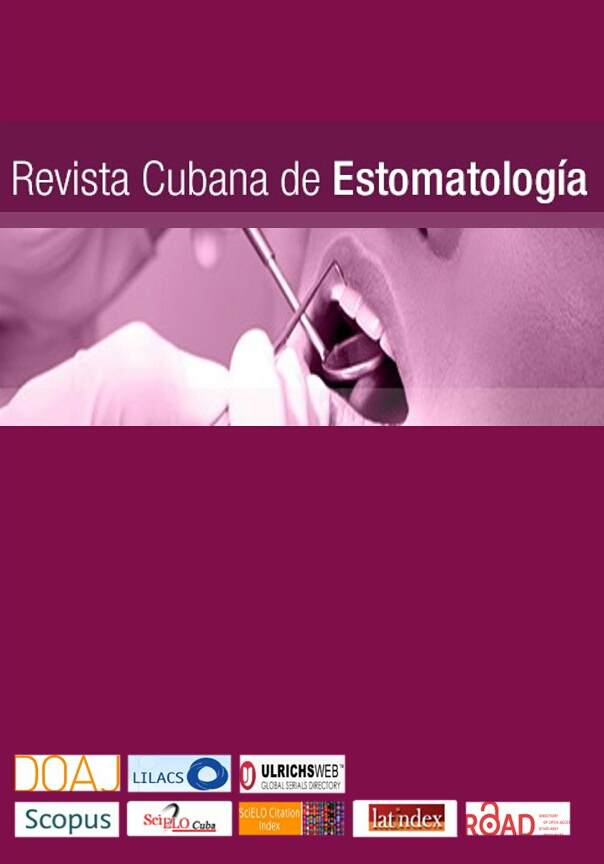Importance of the dentist and the auxiliary oral health team in the diagnosis of syphilis
Keywords:
syphilis, HIV, oral lesions, sexually transmitted infections.Abstract
Introduction: Syphilis is classified as a sexually transmitted infectious-contagious disease with the causative agent Treponema pallidum (Tp). It presents distinct stages of evolution: The primary phase is characterized by the appearance of the hard chancre, the secondary phase by the spread of Tp through the bloodstream and systemic involvement, and the tertiary phase by organ infection and nervous system impairment. In congenital syphilis, the Tp is transmitted vertically from mother to child.
Objective: Report a case in which the dental team participated in the diagnosis of syphilis.
Case presentation: A male 26-year-old patient with leukoderma, HIV-positive and under regular antiretroviral treatment, with no other chronic systemic changes and no previous history of Tp infection, was referred for evaluation by the oral health team. The patient reported having had bisexual relations in recent months with a condom and orogenital contact without a condom. He had not noticed any type of "wound" on the body. Intraoral examination found multiple reddish macules scattered on the lingual dorsum, with a slight detachment and little pain. The quick test was a reagent for syphilis. The patient was referred for evaluation at the medical clinic. Treatment started by two applications of benzyl penicillin with a 7 days' separation between them. Complementary blood tests were also indicated, with special attention to VDRL, which eventually confirmed the Tp infection.
Conclusions: Participation of the oral health team in the diagnosis of syphilis constitutes a complementary force for the improvement of health care processes.Downloads
References
Silva AC. Oral Lesions: a simplified approach for all health professionals. São Paulo: Clube de Autores; 2017.
Takahashi T, Arima Y, Yamagishi T, Nishiki S, Kanai M, Ishikane M, et al. Rapid increase in reports of Syphilis associated with men who have sex with woman and woman who have sex with men, Japan, 2012 to 2016. Sex Transmit Diseases. 2018;45(3):139-43.
Janier M, Hegyi V, Dupin N, Unemo H, Tiplica GS, Potočnik H, et al. 2014 European Guideline on the management of syphilis. J Eur Acad Dermatol Venereology. 2014;28(2):1581-93.
Brazil. Infectious and Parasitic Diseases. 3.ed. Brasília: Ministério da Saúde; 2004.
Saraceni V, Pereira GFM, Silveira MF, Araújo MAL, Miranda AE. Epidemiological surveillance of vertical transmission of syphilis: data from six federal units in Brazil. Rev Panam de Salud Pública. 2017;41(3):44.
Hook EW. Syphilis: an ancient disease in a modern era. Lancet. 2017 Apr 15; 389(10078):1492.
Teixeira LO, Belarmino V, Gonçalves CV, Mendonza-Sassi RA. Temporal trend and spatial distribution of congenital syphilis in the state of Rio Grande do Sul between 2001 and 2012. Cienc Sau Coletiva. 2018;23(8):2587-97.
Albuquerque GMA, Sampaio EMC, Dias LRL, Ferreira KC, Patrocínio CF, Vasconcelos MCA, et al. Complications of Congenital Syphilis: a literature review. Pediatr Moderna. 2014;50(6):254-8.
Park IU, Fakile YF, Chow JM, Gustafson KJ, Jost H, Schapiro JM, et al. Performance of Treponemal Tests for the diagnosis of Syphilis. Clin Infect Diseases. Epub ahead print 9 June 2018. DOI: 10.1093/cid/ciy558.
Pastuszczak M, Wojas-Pelc A. Current standards for diagnosis and treatment of syphilis: selection of some practical issues, based on the European (IUSTI) and U.S. (CDC) guidelines. Postepy Dermatol Alergol. 2013;30(4):203-20.
Avelleira JCR, Bottino G. Syphilis: diagnosis, treatment and control. An Bras Dermatol. 2006;81(2):111-26.
Kassem AM, Bartschi J, Carter KK. Characteristics of person with repeat Syphilis – Idaho, 2011 to 2015. Sex Transmit Diseases. 2018;45(9):68-71.
Oliveira KTA. Caracterização da sífilis em gestantes no município de Codó – Maranhão no período de 2012 a 2017. REAS. Epub ahead print 2019 10 January 2019. DOI: 10.25248/reas.e236.2019.
Gimenez LCO, Oliver LC, Joca CFA, Cavalcanti D, Sousa SCOM. Potential difficulties in the diagnosis of secondary syphilis. Scien Invest in Dentistry. Epub ahead print 2015 14 March 2016. DOI: 10.29232/2317-2835.2015v20i1.
Monteiro CLJ. Sexual risk behavior associated with recidivism of syphilis among young people: case report. Rev Bras Odontol. Epub ahead print 2018. DOI: 10.18363/rbo.v75.2018.e1308.
Motta IA, Delfino IRS, Santos LV, Morita MO, Gomes RGD, Martins TPS. Congenital syphilis: why is its prevalence still so high? Rev Med Minas Gerais. 2018;28(6):e-S280610.
Published
How to Cite
Issue
Section
License
Authors retain all rights to their works, which they can reproduce and distribute as long as they cite the primary source of publication.
The Rev Cubana Estomatol is subject to the Creative Commons Attribution-Non-Commercial 4.0 International License (CC BY-NC 4.0) and follows the publication model of SciELO Publishing Schema (SciELO PS) for publication in XML format.
You are free to:
- Share — copy and redistribute the material in any medium or format.
- Adapt — remix, transform, and build upon the material.
The licensor cannot revoke these freedoms as long as you follow the license terms.
Under the following terms:
Attribution — You must give appropriate credit, provide a link to the license, and indicate if changes were made. You may do so in any reasonable manner, but not in any way that suggests the licensor endorses you or your use.
- NonCommercial — You may not use the material for commercial purposes.
No additional restrictions — You may not apply legal terms or technological measures that legally restrict others from doing anything the license permits.
Notices:
- You do not have to comply with the license for elements of the material in the public domain or where your use is permitted by an applicable exception or limitation.
- No warranties are given. The license may not give you all of the permissions necessary for your intended use. For example, other rights such as publicity, privacy, or moral rights may limit how you use the material.


